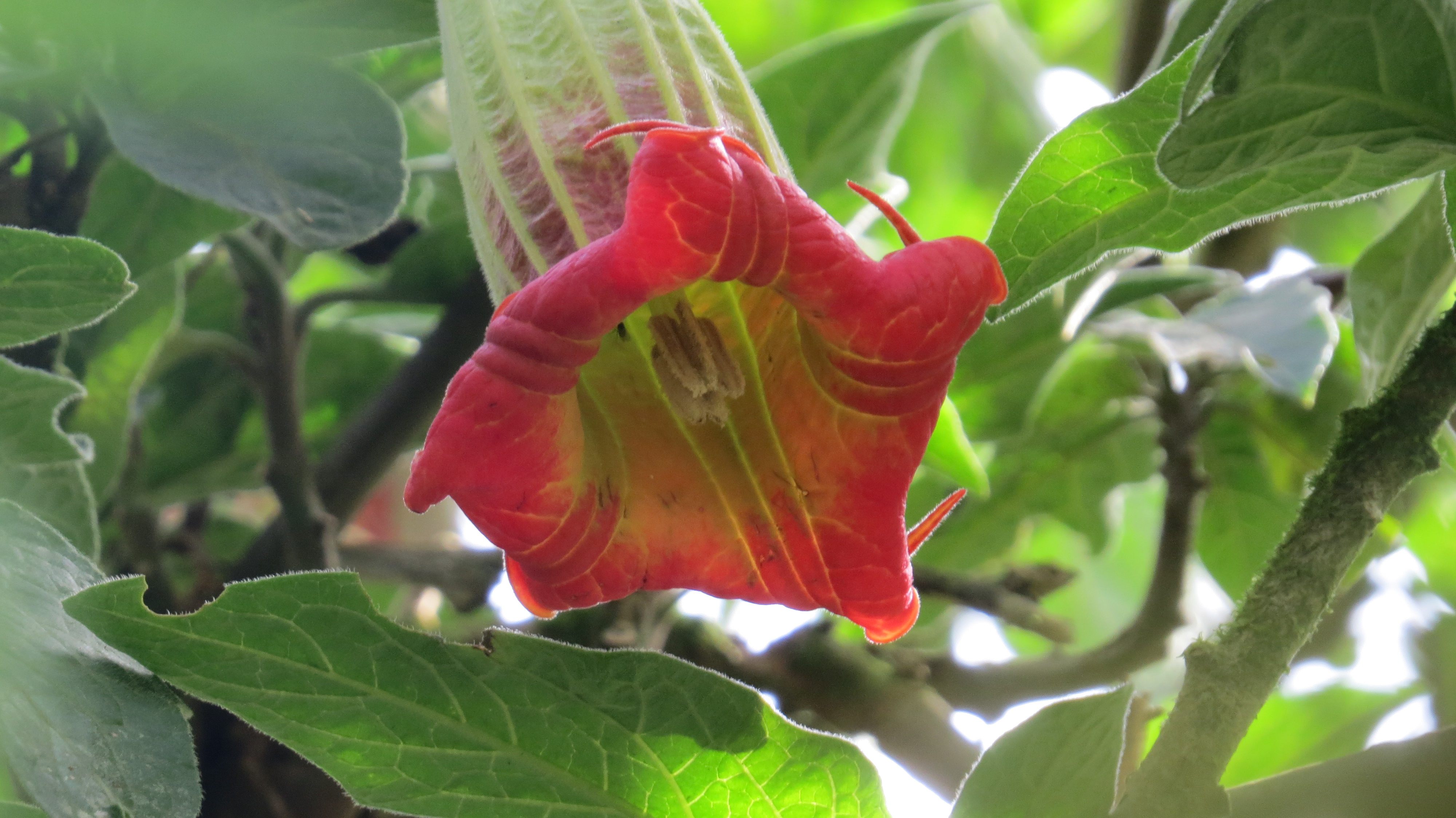Escopolamina: The Complex History of Devil’s Breath
Escopolamina: The Complex History of Devil’s Breath
By Cade C. Campbell (Email: campbellc6@etsu.edu ; Instagram: @cadeccampbell)
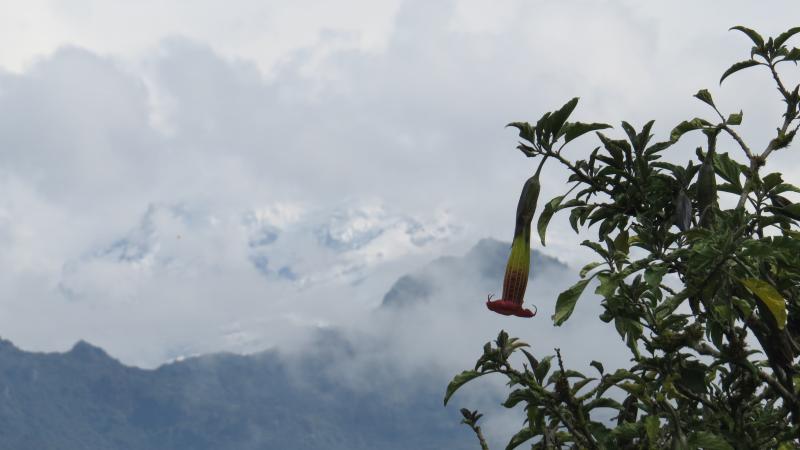
Red Angel's Trumpet (Brugmansia sanguinea) at the base of Antisana Volcano. Photo by Cade Campbell.
Hiking alone through the waving grasses of the high ridgeline, rolling pastures reminded me of home in the Appalachian Mountains. Swallows danced in the skies above Rancho del Cañón, rabbits danced in garden beds of potatoes and beans fringed by dense, inviting forests on a cool afternoon. Incongruities slowly became obvious. Instead of dogwood trees, the contorted, papery trunks of the queñua lined the road, transplanted Polylepis pauta from above the “treeline.” A dusty, wooden sign read “No caza o fuego” with a carved silhouette of a shotgun and flames. “No hunting or fires” is a common sentiment shared across many protected habitats in my montane stomping grounds far across the equator. Hidden beneath a lush, green blanket of mountainside woods, a few crimson leaves of tank bromeliads and silvery airplants were visible from the canyon. The jarring call of a mountain-toucan echoed from the hillside, a quick reminder that I was indeed far from home.
As I crested the hill, I paused to appreciate the misty, sun-dappled landscape. Complete silence greeted me at the summit. In the surrounding lowlands, there always seemed to be an acoustic blanket of birds, insects, frogs, and mammals singing into the abyss. Not here. Cliffs and narrow waterfalls rose thousands of feet into the air on either side of the hill where I stood. A thick veil of gray clouds silently parted in distant winds, and I stared in disbelief as the entirety of the almost 20,000-foot-tall (5,074 meter) Antisana Volcano materialized in front of me. The peak was frozen in the great, blue grasp of some of the last remaining Andean glaciers. Where I stood in the watershed of a tributary destined for the Amazon River, more ice than I could fathom was looming in a giant, ominous spire piercing through the clouds. By far the largest mountain I’ve ever seen, the ice glowed blue as if it were one with the sky, ice threatened by the heat of a changing world.
The trail was carrying me across the fringes of the Ecuadorian páramo, a vast expanse of the greater Andean tundra stretching across western South America. While my friends rested in the hot springs at the foot of the mountain, I decided to embark on one last botanical adventure before leaving the country. Before traveling to Ecuador, I had never even flown on a plane. In a conservation biology lecture, I learned about a Geosciences expedition to the Andes Mountains of Ecuador which would occur the following spring from my university. With a love for biodiversity and exploring new relationships that different people have with it, I did some detailed research about the destination. A place home to more biodiversity than any other, and a montane heritage of enriching history that lives on in the modern skills and traditions. After discussing the possibility of joining the trip with my professors and advisor, I applied for a competitive study abroad scholarship (which I received) to join a small, mismatched band of geologists and two fellow aspiring biologists to learn about the ethnobotany, ecology, volcanoes, glaciers, and culture of the Andes Mountains from local experts and time spent exploring on my own.
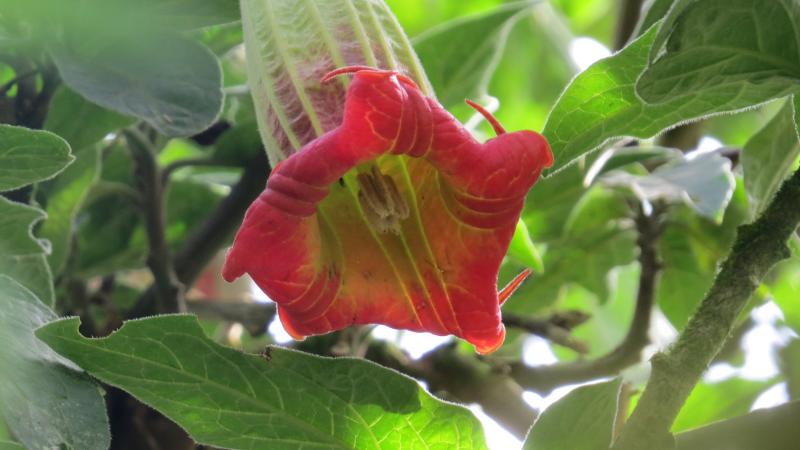
The flower of Red Angel's Trumpet (Brugmansia sanguinea) on Rancho del Cañón. Photo by Cade Campbell.
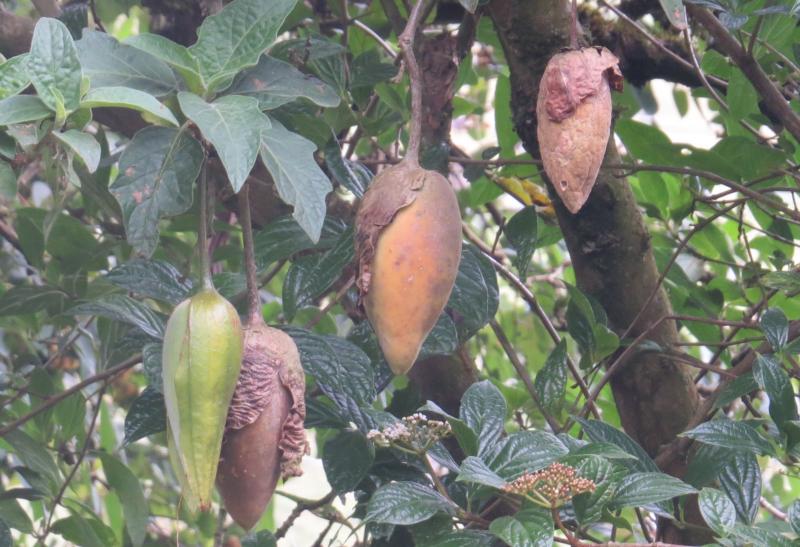
The fruit of Red Angel's Trumpet (Brugmansia sanguinea), used to produce escopolamina. Photo by Cade Campbell.
On the hillside, my lone companion was a stunted tree. With a weathered, mossy trunk spiraling into contorted branches, the tree would have been very distinct even if it were surrounded by the thousands of others in the valley. On the tip of almost every twig, an enormous, scarlet flower dangled in the breeze. Against a background of glacial ice, the tropical flowers were accompanied by swollen fruits, untouched by humans and wildlife in this meadow. They were left alone for good reason. Trumpet flowers in the genus Brugmansia are known for their toxicity around the world. They are partially responsible for the success in over 50,000 crimes annually throughout the northern Andes Mountains (Mulligan, 2018). Potentially lethal, as are most plants with such a reputation, trumpet flowers are not weapons of murder. Instead they possess the ability to steal away a human’s arguably most important dichotomy, an individual’s free will.
While seemingly dramatic and cloaked in mythology, the effects are very real. Once considered a South American member of the more familiar Datura genus, Brugmansia also contains psychedelic compounds. Certain dosages can cause psychological turmoil from violent hallucinations to peaceful incapacitation. Biochemistry designed to disorient predators and stimulate pollinators has been co-opted by humans for deceit, for millennia. In the highlands of the Andes, some individuals still know the ancient pre-Incan tricks to manufacture a specialized, potent powder from the plant. Known as “Devil’s Breath,” the powder is used in a variety of illicit occupations. Mostly used in theft, perpetrators often blow a strong dose of the powder into the face of an unsuspecting victim. Others creatively brew a liquid solution, soaking a business card or coca leaf packets in the solution, destined for any strangers presumed to be wealthy. Scopolamine is the compound responsible for these maneuvers, one of many nefarious tools of the nightshade family Solanaceae.

Agroforestry at Hacienda Verde. The endangered Andean Dry Forest sprawls in the distance, where ancient Quitu-Cara ruins still protrude from the mountainside. Photo by Cade Campbell.
Through my project, I had the opportunity to meet Fabián Bucheli, who stewards the agrodiversity-focused farm Hacienda Verde with his wife (and internationally renowned ethnobotanist) Dr. Lucía de la Torre. They cultivate, curate, and give tours of their internationally renowned living museum and farm integrated into the threatened Andean dry forest called Hacienda Verde. He gave my friends and I a detailed debriefing about the plant when we passed a tall, white variety in his garden, paraphrased below. “This one is called escopolamina,” he said, after describing its role in the garden, “You could walk around a street corner and suddenly wake up in a room over a dead body holding a gun, remembering nothing. Be careful who you take a drink from, you might end up in the trunk of someone’s car without your pants!”
He told us that his variety, a White Angel’s Trumpet (Brugmansia arborea), was not terribly potent compared to others. The most dangerous variety, he said, was known to grow in the highlands. With deep scarlet-red flowers, swollen fruits, and a tree-like stature, it grows at alpine levels at the highest possible elevations survivable to such a tropical plant. As I watched the red flowers sway in the mountain air at the summit of that highland ranch, I remembered the warning. Escopolamina.
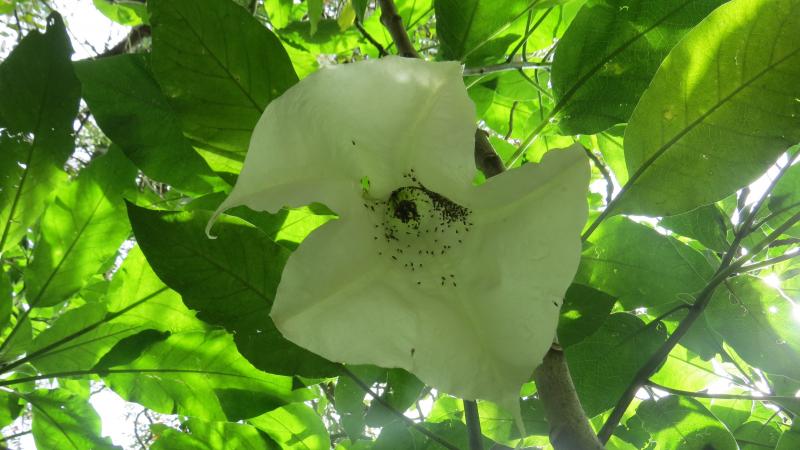
An abundance of Dipteran pollinators visiting White Angel's Trumpet (Brugmansia arborea) at Hacienda Verde. Photo by Cade Campbell.
It would seem such a plant would have a vile reputation, but Brugmansia is not an “evil” plant just because some people decide to use it with the intent to harm others. The trees were proudly displayed along the ranch’s trails and the curving, gravel roads of the western Andes. Local shamans know the plants as “mishas,” and they have a very different outlook than modern chemophobic tendencies recommend to us. Dosage is key in medicinal plants, and shamans have thousands of years of experience in the form of oral and written tradition. Their medicines were powerful pain relievers, used to combat inflammations from skin rashes to arthritis. The psychoactive properties are also harnessed by dosage, giving shamans and patients alike the ability to induce dreams in traditional spiritual ceremonies, some of which are even in conjunction with various Ecuadorian Iglesias (Vincenzo De Feo, 2004).
As exotic as Brugmansia might seem, its future could lie close to home in almost any temperate or tropical region across the world. At the small, hilltop methodist church I attended as a child, there was a sprawling garden where plants from native wildflowers and medicinal plants to exotic shrubs for purely aesthetic purposes grew. Along the walkway, a large, yellow-flowered Brugmansia always thrived during the summer. Unlike their arbuscular growth with the stability of Ecuadorian climates, the plant died each winter. But before the frost could kill the plants, cuttings were sliced from the stem. Brugmansia roots readily from cuttings, and if it is started soon after the first frost, a small tree was ready to plant outside in the spring.
Vicki Kidd, a long-time member of the church and preschool teacher, was their guardian. Each year, she left a bucket of cuttings at the church, given freely to anyone who wanted to grow the plant. Here, the plant’s alternate name was “Angel’s Trumpet,” and late-summer congregations were always greeted with the fragrant flowers and the visiting pollinators inside each blossom on Sunday mornings. Kidd also reared monarch caterpillars and many other native plants to educate the small children about the importance of stewardship and local ecology, but this tall, tree-like flower was popular with everyone and provided a segue into a broader context of ecological preservation. In the mountains of Tennessee, a plant with a violent history was known by the innocent name of “Angel’s Trumpet.” In the Andes Mountains, Brugmansia is considered “extinct in the wild.” For millennia the plant has relied on human cultivation to thrive, and as cultural values change and emphasis is strayed from the traditional importance of such plants, they are under the threat of complete extirpation. Still, thousands of miles from home, some of the “extinct” plant’s genetics were alive and well.
As I was immersed in the Quechua and highland vaquero steeped culture of the Andean highlands, it was evident that the “Angel’s Trumpet” lost a great deal of its significance beside the little church in Indian Springs, Tennessee. A shamanic tradition was not carried with this “exotic” plant when it was live-staked year after year into soil saturated by cool, spring rain in the ancient mountains of my home. Nevertheless, the plants were safe. If something were to happen to the already extinct-in-the-wild populations of the Andes, some would still thrive in small communities capable of resurrecting them across the ocean. Here in Tennessee, and beyond.
This isn’t the first time Appalachia has been a refuge for obscure varieties of plants. Glaciers once scathed the northern United States, and the entirety of the indigenous biodiversity of the northern U.S. was withheld by the montane forests of the Southeast. Today, a warming climate is creating a biodiversity highway through the mountains as sweltering heat pushes many species northward from the Deep South. Clinal farms and gardens might provide an entirely different form of refuge. Varieties of potatoes, tomatoes, and beans, staple crops originating from the Andes, already reinforce traditional Appalachian gardens and have for millennia. Equatorial species contribute to food security and local food autonomy in Appalachia. Why can’t other species do the same?
There is a risk throughout the Ecuadorian Andes of cultivated plants being lost. Wild, native plants dispersed through the ecosystem are suffering too, but these crops need the direct assistance of humans to survive. Changing cultural values and climates provide grounds for the dispersal of these plants to other communities. Ultimately, my hopes are to introduce some Ecuadorian varieties of crops and other plants to rural Appalachia. The risk of invasive-exotic establishment is low due to seasonal temperature differences, and that of disease by geographic proximity. With care to use niche modeling and geospatial analysis, such a project could benefit small mountain communities on a global scale. Currently, I plan to work with Appalachian ethnobotanist and mentor Ryan Huish to apply species and ancestral strategies to make this conservation more of a reality and help begin correspondence between Appalachian and Andean agroecosystems. Anyone with additional advice on how to access and respectfully protect these plants ex-situ, and how to acquire the proper USDA permits, would be greatly appreciated.
As an ethnobiologist-in-training, I also appreciate any feedback (positive or negative) from readers who have advice or concerns about my plan. As a student graduating this December, please reach out if you are a professor seeking graduate students around the Southeastern U.S. or elsewhere involved in ethnobotanical research. Finally, thank you for the opportunity to be part of this community and contribute to this publication.
Bibliography
Campbell, C. (2022). Journey to the Middle of the Earth. ArcGIS StoryMap. https://storymaps.arcgis.com/stories/6139d1af48184767ab065fb4e13ed0d4
Knapp, G. (1991). Andean Ecology: Adaptive Dynamics In Ecuador (1st ed.). Routledge. https://doi.org/10.4324/9780429046186
Mulligan, R. (2018). Scopolamine: Myths and realities. The Bogotá Post. https://thebogotapost.com/scopolamine-myths-and-realities/31604/
Vincenzo De Feo. (2004). The Ritual Use of Brugmansia Species in Traditional Andean Medicine in Northern Peru. Economic Botany, 58, S221–S229. http://www.jstor.org/stable/4256919

